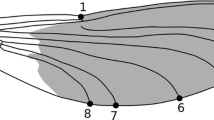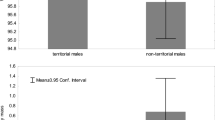Abstract
Fluctuating asymmetry is a measure of developmental instability and results from both genomic and environmental influences. Levels of asymmetry are (in part) influenced by mechanical constraints, as asymmetry is believed to reduce efficiency. Here we have investigated the influence of habitat structure (“open” and “cluttered” environments) on primary flight feather asymmetry and flight performance in European starlings. Our findings indicate that the increased flight demands of cluttered habitats act to reduce primary asymmetry and increase flight performance. These data are discussed in terms of the influence of asymmetry on flight performance and the mechanisms that give rise to asymmetry. This study also presents a novel method, i.e., examining within-individual changes in asymmetry, by which the detrimental and positive influence of the environment could be studied in subsequent field and laboratory studies without confounding environmental effects with genomic influences.
Similar content being viewed by others
Author information
Authors and Affiliations
Additional information
Received: 16 June 1997 / Accepted after revision: 28 December 1997
Rights and permissions
About this article
Cite this article
Swaddle, J., Witter, M. Cluttered habitats reduce wing asymmetry and increase flight performance in European starlings. Behav Ecol Sociobiol 42, 281–287 (1998). https://doi.org/10.1007/s002650050440
Issue Date:
DOI: https://doi.org/10.1007/s002650050440




